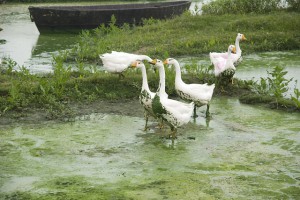Fertilizers contribute to toxic algal blooms
 Photo Credit: Greenpeace China
Photo Credit: Greenpeace China
A joint report between Resource Media and the National Wildlife Federation details the severe consequences of toxic algal blooms in the United States. While most algae are not harmful to humans, some blue-green algae can produce poisonous toxins. Most of these algae are microscopic, but in high-nutrient conditions they can bloom, taking over entire bodies of water. These algal blooms can devastate the local environment, and are dangerous to human health. Blue-green algae can produce harmful toxins that, in severe cases, can cause asthma-like symptoms, severe vomiting, diarrhea or irritated skin or eyes. These symptoms can be even more severe with increased contact, and have caused over 27 dog deaths since 2001. Toxic algae have also been blamed with killing brown pelicans, bald eagles, sea otters, ducks, and fish. Agricultural runoff of synthetic fertilizer and manure is the leading source of nutrients that these toxic algae thrive on, but contamination also occurs from failing septic systems, municipal and industrial wastewater, and residential lawn fertilizers. Unfortunately, these toxic algal blossoms may be more severe in the future due to climate change. Changes in rainfall and temperature could increase nutrient runoff while decreasing water volume and warming water temperatures, thus creating conditions that encourage algal growth. Decreased fertilizer use and improved timing will be crucial for controlling algal blooms in the future. Wetlands and streamside buffers can also help keep nutrients out of waterways.


